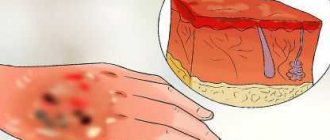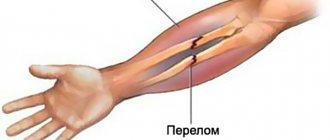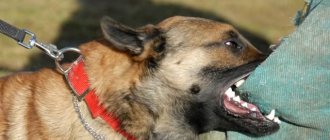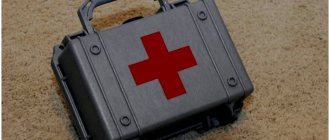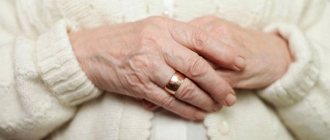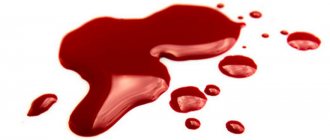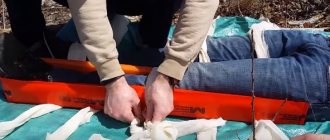A gunshot wound is often encountered in medical practice and is considered a very serious injury. Such an injury can be caused by the impact of a firearm (bullet, shrapnel, shot).
Gunshot wounds are completely different in nature from other injuries, and can lead to a variety of consequences, even death. Correctly and timely first aid for a gunshot wound can not only alleviate the condition of the victim and prevent further complications, but also save a person’s life.
Peculiarities
A gunshot wound has features that significantly distinguish it from other injuries. Soft tissue necrosis occurs around the injury, the edges are torn and cannot be compared. A through bullet wound has two bleeding holes - the diameter of the entrance is usually smaller than the diameter of the exit. The extent of the damage depends primarily on the type of weapon from which the person was shot.
Gunpowder residues and foreign objects usually remain inside the wounds. If the victim was not provided with first aid, secondary necrosis will begin to develop around the area of the gunshot wound.
Gunshot wounds can be complicated by other conditions of the victim: traumatic shock, hypotoxicity or excessive bleeding. General signs of a bullet wound are called “wound disease”, which is accompanied by: metabolic disorders, respiratory system, endocrine, heart failure and central nervous system.
With such damage, other local signs may also form:
- fractures;
- hemorrhages;
- organ damage;
- violation of the integrity of nerve endings.
Providing first aid for gunshot wounds is very important for the victim, because even when wounded in the arm, when the bullet does not touch vital organs, the wounded person can die from severe bleeding.
How severe the damage will be depends not only on the size and other properties of the projectile, but also directly on the affected tissue - elastic tissue will withstand the impact of a projectile much easier than hard and brittle tissue. The size of the affected area is also influenced by the action of secondary projectiles - these can be both biological and non-biological bodies that are formed when a bullet interacts with various obstacles: clothing, various objects or parts of a disintegrated projectile.
At the moment a bullet collides with a person’s body, a temporary pulsating cavity (TPC) appears with the presence of excess pressure. The size of such a cavity significantly exceeds the caliber of the cartridge (more than 30 times). Such temporary cavities can only form from bullets whose impact speed exceeds 300 m/s.
Injuries to the chest, abdomen, limbs
Assess the general condition of a person using a survey. Ask him a simple question about his name or how old he is. After a gunshot wound to the chest, abdomen or limbs, a person is most often conscious.
What not to do before the ambulance arrives:
- If a person is unconscious, do not try to revive him;
- During emergency care, you should not offer the victim anything to drink or eat (it is permissible to wipe his lips with a cloth soaked in water);
- Remove bullets and other foreign objects from the wound;
- Reposition prolapsed internal organs;
- Do not attempt to clean dirt or dried blood from the wound.
Remember the correct position for an unconscious person: his head should be turned to the side. If the victim responds to questions, gently bend his knees.
Note!
When helping a person after a gunshot wound, try to move him as little as possible.
Classification
Depending on the type of striking object, the classification of gunshot wounds has two types:
- Splintered;
- Bullets.
Wounds are also distinguished based on the nature of the injuries inflicted:
- soft tissue lesions;
- damage to bone integrity;
- damage to nerves and blood vessels;
- causing damage to internal organs.
All types of gunshot wounds require mandatory treatment in a hospital setting. If the wound surface is not treated in time, there is a risk of infection, which can lead to complications.
Gunshot wounds and first aid
A wound that results in projectile fragments, bullets, and shot entering the human body is called a gunshot wound. Such injuries are classified as fatal, so the person must be immediately taken to a medical facility.
First aid for a gunshot wound is provided according to the general algorithm, regardless of the striking object that caused it. However, there are minor differences in emergency actions depending on the location of the injury.
Medical assistance for gunshot wounds is the only way to save the victim’s life, so contacting a healthcare facility should be mandatory.
However, before calling the emergency dispatcher, you need to determine the severity of the injury and the general condition of the victim. In case of severe bleeding, when there is a large loss of blood, it must be stopped immediately.
To do this, in case of arterial bleeding, a tourniquet is applied, and in case of venous bleeding, a pressure bandage is applied. Once the danger of fatal blood loss has been averted, you can call an ambulance.
In a conversation with the dispatcher, you need to point out the following facts:
- Type of injury;
- Type and presence of bleeding;
- Localization of the wound.
The type of injury is extremely important in determining the severity of the injury. Doctors divide bullet wounds into 2 types:
- Isolated (one cavity of the human body is damaged);
- Combined (2 or more cavities are injured).
Combined injuries are extremely life-threatening: the fatal outcome after them reaches 80%.
Note!
If the dispatcher indicates that the ambulance will not be able to arrive at the scene within half an hour, then the victim must be transported independently! To do this, use personal transport or cars following a passing route.
After the issue of delivering the victim has been resolved, they begin to provide first aid for a bullet wound.
Head wounds
Gunshot wounds to the head are varied. They are made from pistols, shotguns, and self-propelled guns. No less dangerous are injuries caused by objects that are not classified as firearms: spearfishing devices, crossbows or pneumatic guns.
A characteristic feature of “modern” head wounds is the “point” location of multiple wounds (no more than 2-3 mm in diameter). Most often they are obtained as a result of being hit by a shot.
If a shot is fired into the head from a long distance and the bullet hits the scalp, it is difficult to determine the wound during the initial examination.
When shot at point-blank range or at close range, the wounds are deep and have a large volume.
Note!
In the case of a head wound, the victim’s condition is assessed based on 3 factors:
- Reaction of the eyes to irritation by sound and pain;
- Verbal answers to asked questions;
- Motor ability.
Wounds to the head are often accompanied by traumatic shock. Its appearance is provoked by large external or internal blood loss. Therefore, the victim falls into an unconscious state and it is extremely difficult to bring him out of it.
Note!
If the victim has a decrease in the number of heart contractions, this indicates a developing intracranial hematoma. In this case, only emergency surgery can save a person.
In case of a gunshot wound to the head, it is important to try to bring the victim out of shock. For this purpose, analgesics that do not contain narcotic components are used. The use of non-steroidal anti-inflammatory drugs with an analgesic effect is also indicated.
Note!
Bone fragments or foreign objects that have entered the wound cannot be removed independently. This will cause profuse bleeding. Before the ambulance arrives or the victim is taken to the hospital, you can only apply a sterile bandage to the wound. For severe bleeding, use a pressure bandage.
Considering that foreign objects (bullets, shrapnel) change their location while the patient is being moved to a medical facility, transportation is carried out with extreme caution. If there is no consciousness, the patient is placed on his side. If there is vomit, blood and mucus in the oral cavity, it must be cleaned before transportation.
Assess the general condition of a person using a survey. Ask him a simple question about his name or how old he is. After a gunshot wound to the chest, abdomen or limbs, a person is most often conscious.
What not to do before the ambulance arrives:
- If a person is unconscious, do not try to revive him;
- During emergency care, you should not offer the victim anything to drink or eat (it is permissible to wipe his lips with a cloth soaked in water);
- Remove bullets and other foreign objects from the wound;
- Reposition prolapsed internal organs;
- Do not attempt to clean dirt or dried blood from the wound.
Remember the correct position for an unconscious person: his head should be turned to the side. If the victim responds to questions, gently bend his knees.
Note!
When helping a person after a gunshot wound, try to move him as little as possible.
If there is bleeding, determine its type.
- Arterial bleeding. The blood is bright red and “comes out” of the body in a pulsating fountain. To stop the loss of arterial blood, the vessel is pressed with a finger in the wound. To do this, insert your fingers directly into the bullet hole. If the blood continues to spurt out, slowly move them in the wound until you feel the damaged vessel. Then a tourniquet is applied if the wound is on a limb, or wound tamponade is performed on other parts of the body.
- Venous bleeding. It is characterized by viscous dark blood that comes out of the wound without pulsation. To stop it, you need to grab a part of the skin along with the damaged vessel and fix it in this state. If the wound is located above the heart, the vessel is clamped above the wound. In a situation where it is located below the heart, the vessel is clamped below the wound. If blood vessels are damaged on the extremities, apply a pressure bandage. If the chest cavity or abdomen is injured, tamponade is used.
- Capillary bleeding. Blood flows out in drops from damaged vessels. As a rule, its amount is insignificant. The loss of capillary blood can be stopped by applying a pressure bandage or squeezing the capillary with a finger. Before this, the skin around the wound must be treated with an antiseptic.
Note!
In case of a bullet wound to the soft tissues of the leg and arms, stopping the bleeding is necessary. If it is not possible to apply a tourniquet or pressure bandage, close the vessels with your fingers until medical personnel arrive.
After the bleeding has stopped, a pressure aseptic bandage is applied. Before this, it is necessary to disinfect the surface around the wound. It needs to be processed in the following sequence:
- A little antiseptic is poured onto the skin area near the wound;
- Gently wipe it with a bandage or cloth;
- The next area, located near the wound, is treated in the same way, but with a different bandage or cloth;
- In the absence of an antiseptic, use plain water.
- Then the cleansed skin is lubricated with iodine or brilliant green.
Note!
It is prohibited to pour antiseptics into the wound itself! It can be sprinkled with Streptocide powder.
The bandage is applied to all bullet holes on the body: incoming and outgoing. First, place a clean bandage or cloth on the wound, then cover it with cotton wool. For thoracic wounds (damage to the chest), the cotton wool is replaced with a bag or oilcloth. If they are absent, the material is generously lubricated with greasy cream, ointment or Vaseline. “Oiled” fabric is used instead of polyethylene.
The finished structure is tightly wrapped to the body using a bandage or other available dressing material (torn clothes, pieces of cloth, even tape).
After the bandage is applied, place a cold object on it. However, remember that you cannot use snow or icicles. Place the victim in the position that you think will be most comfortable for him. For chest injuries, be sure to bend the person’s knees, giving him a semi-sitting position.
Warm the patient by wrapping him in blankets. This action must be performed regardless of the time of year.
Note!
If the applied bandages become saturated with blood, do not remove them to apply new ones. It is enough to apply another layer of bandage on top of the existing bandage.
If you have a first aid kit, you can administer an antibiotic intramuscularly to the victim, which has a wide spectrum of action. If the bullet wound was in the chest, leg or arm, you can give the victim an antibiotic in tablet form. Be sure to give analgesics that do not contain narcotic components.
Before doctors arrive or the victim is taken to a medical facility, you need to constantly talk to him. It is advisable to record vital signs all this time: blood pressure and heart rate.
Tamponade
Correctly applying a tourniquet is extremely difficult for a beginner who is faced with a critical situation for the first time. Any inaccuracy in this case can cause necrosis (death) of tissue on the limb being pulled. Therefore, doctors recommend using tamponade as a way to stop bleeding on the extremities.
Let's consider how to correctly use this method of stopping blood loss.
- Prepare bandages or materials that replace them (fabric, clean clothes);
- Tear or cut them into strips, the width of which does not exceed 10 cm;
- Place the edge of the resulting tape into the wound, push it as deep as possible;
- Then, sequentially, collecting 2-3 cm of a new piece of tissue with your fingers, immerse it in the wound;
- This is done until the hole is completely closed with a “plug” of material.
- Incised wound: first aid for an incised wound and features of treatment of an incised wound.
- The section of the wound where granulations appear first
- PSO, primary surgical treatment of wounds: types, description, implementation || Set of instruments for primary surgical treatment of wounds
- How to draw out pus from a closed wound - Treatment of arthrosis and arthritis, treatment of gout
First aid
In traumatology, gunshot wounds are quite common and are usually accompanied by complex injuries. Complications can only be prevented if the victim is taken to the hospital as soon as possible. When providing emergency assistance, it is first of all important to save the life of the victim, as well as determine the type and severity of the injury.
When a bullet hits a person's body, deep wounds occur. Very often, the projectile may not go through and remain inside the person, and then it is necessary to remove it as soon as possible. To properly provide assistance, you must perform the following steps in turn:
- Stopping bleeding - it is necessary to determine the nature and location of the damage. Bullet wounds bleed a lot. If a limb is injured, a tourniquet must be applied. In the warm season, the tourniquet can be applied for no more than 2 hours, and in cold weather for no more than an hour and a half. Be sure to place a piece of paper under the tourniquet on which to indicate the time of application. Also, to stop bleeding, you need to apply a sterile bandage to the wound, and bandage it as tightly as possible.
- Pain relief - in order to prevent the victim from experiencing painful shock, he must be given a painkiller, which is available in the first aid kit (analgin, ketanov, etc.).
- Take the victim to the nearest medical facility. If it is not possible to do this yourself, you need to call a medical team and wait for their arrival. Upon the arrival of doctors, it is necessary to describe as accurately as possible how the injury occurred, what medications were given to the victim, and how long ago the tourniquet was applied.
How damage occurs
Before we explain how to treat a gunshot wound, we need to take a little closer look at how the damage occurs in the first place. First let's see what the bullet looks like. This is a small case that contains the charging powder. When a person fires a bullet, it travels at incredible speed (about 1500 meters per second), the speed varies and depends on the actual bullet, its weight and the weapon it was fired from.
When the bullet hits its target, the powder charge explodes and damages everything nearby. Typically the upper body (head and abdomen) is the most vulnerable, and if struck by a bullet, a person may suffer rapid blood loss and severe damage to internal and vital organs.
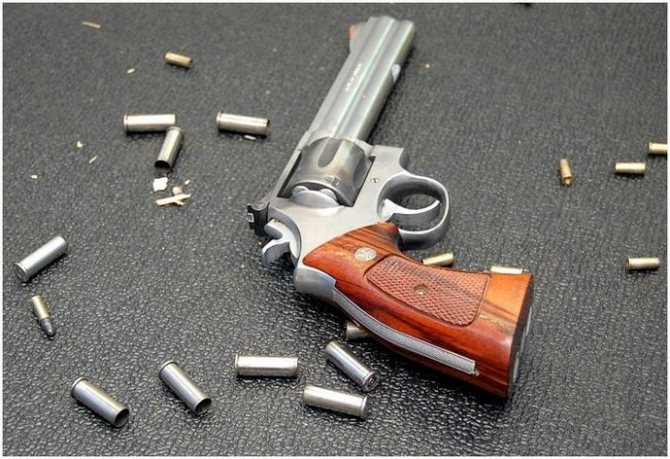
Let's take a closer look at the damage a bullet can cause. When a bullet enters the body, it begins to tear tissue, muscle and other body structures along its trajectory. Some inelastic tissues, such as the brain, may suffer more because they cannot regress like other tissues (such as skin). Usually a and‘ A cavity appears in the damaged area that cannot be repaired, leaving the wound open to infection and a high risk of blood loss. In some cases, the bullet may enter the body on one side and leave on the other, which can lead to further progression of blood loss.
The outcome of a gunshot wound may vary, but most injuries are as follows:
- Severe bleeding/blood loss
- Damage to vital organs.
- Broken Bones
- infection
- paralysis
- death
In general, surgery is necessary to remove the pieces from the bullet, and if there are broken bones, the bone pieces should also be removed as they can seriously damage nearby tissue or organs. In addition, the wound must be washed, disinfected and sutured.
Diagnostics
Upon arrival at the hospital, the doctor diagnoses the injury based on your medical history and tests. When collecting anamnesis, it is important to find out exactly how the injury occurred and how much time has passed since the injury. The severity of the wound can be diagnosed by the general condition of the patient. If the injury is severe, then all diagnostic measures are carried out together with resuscitation actions.
Shrapnel gunshot injuries require immediate surgical intervention, with removal of fragments from soft tissues. But before the operation, the patient undergoes several laboratory tests.
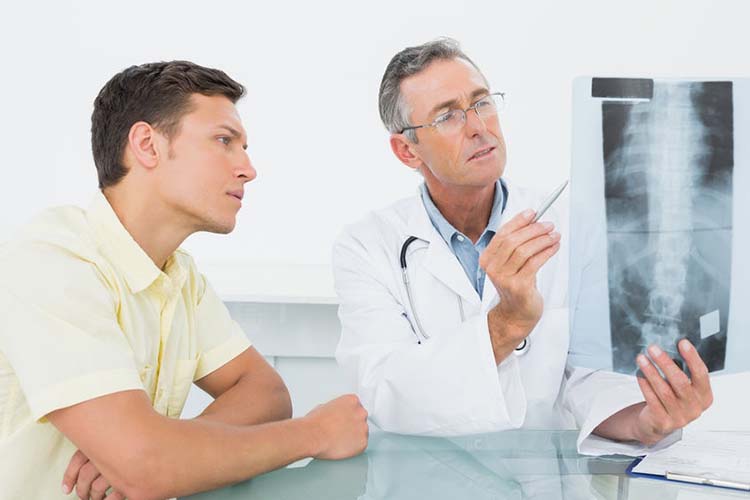
Also, during the diagnostic process, it is necessary to accurately determine the depth of the wound and the presence or absence of associated injuries. For this purpose, the victim is given:
- radiography;
- computed tomography;
- magnetic resonance imaging;
- ultrasound scanning.
Gunshot injuries can be very serious and lead to dire consequences. How quickly the victim received emergency care and was taken to the hospital depends on his treatment and the risk of serious consequences.
Treatment of a bullet wound
Before starting wound treatment, it is necessary to assess the severity of the injury. You have to look for the bullet, and you may even have to remove it so you can safely clean the wound. If the bullet remains in the wound, the infection can progress and worsen the victim's condition.
In other cases, there may be small bullet fragments left around the wound, but this can cause more damage if you try to remove them rather than leaving them there. If you are having surgery and the medical staff can perform the operation, you may also want to remove all parts of the wound.

If you are somewhere outdoors and far from a hospital or emergency room, you should at least try to remove the larger pieces of the bullet so you can clean and disinfect the wound. You must bandage the wound and make sure to stop the bleeding before you can find a hospital. You should change the bandage regularly and keep it clean at all times to prevent infection. This may be your main concern. If you have managed to control the bleeding, your next threat is infection.
If you have antibiotics, of course take them. They will prevent the development of any infection that may begin after injury. Also, don't hesitate to take pain medications (if you have them). They will feel the pain and keep you healthy and focused to find your way back to civilization so you can get the right help.
And here's another important thing that can help you. Depending on where you were shot, you should keep the wound above the level of your heart. For example, if you get an injection in your leg, the best thing you can do is keep your leg slightly elevated above the level of your heart. This will prevent blood from rising up into your leg and causing too much swelling.
If someone else (your hiking/camping partner, friend, or relative) has been shot, you should seek treatment yourself before arriving at the hospital. Your first 5 actions are calls and #8216; A, B, C, D, E'. Here's what they mean:
- Airway (A) - This is one of the most important things you should check first if the person is still able to breathe. If they are conscious and able to talk and have no trouble breathing, then they are fine and the airway is clear. In cases where the person is unconscious, they must assess whether they can breathe or whether the airway is obstructed in any way. Check your throat with your mouth open and see if anything is blocking your airway. If your tongue is in the way, try moving it out of the way. It is often possible that the shock has caused the person to literally swallow their tongue, causing them to choke. If the tongue does not interfere, then there may be blood in the throat (if, for example, the person was wounded in the lungs, throat, or other vital organs that damage the lungs). Try to remove accumulated blood by turning the person so that the blood leaks out through the mouth or by absorbing it with a cloth.
- Breathing (B) - If you have successfully completed the above, it is likely that you have already determined whether the person can breathe or not. If, for example, there is no obstruction to the airway and the person is still unconscious, there is a possibility that he will not be able to breathe. You may need to perform mouth-to-mouth breathing to get the person to breathe again. Always check to see if your chest is rising or falling (a good indicator for breathing). Also, do not ignore factors such as strange, fast or any unnatural breathing that a person has, even if they are conscious. There is a possibility that something is happening and you should be prepared for any changes in the victim's behavior.
- Circulation (C) - It has to do with circulation and the extent to which it can cause serious blood loss. You should apply pressure to the wound to minimize any additional blood loss that may occur. Also, regularly check the victim's pulse at the wrist or throat. If the person is unconscious and has no pulse, you may need to perform CPR (breathing for rescue).
- Disability/Deformity (D) - This check is important before going any further to help the victim. This means that if a person has a spinal cord injury (disability) and you try to move it, it may be different from how you found it could make your situation worse if it stays permanently. disabled people. By deformity we mean that a person can suffer an injury that somehow deforms their body in an unnatural way (strangely broken limbs, joints, etc.). They are closely connected to the nervous system, and any movement can cause further damage. This is why it is so important that you evaluate this first before taking any action. In general, the Red Cross advises that if a person is suffering from a spinal cord injury, they should not move it until help arrives, or if they need to move it, for example to help them breathe, they should be very careful and move it a lot. slowly. But this is only in extreme situations when a person is not breathing. Helping them breathe is the first priority.
- Exhibit (E) - It is also important that you find as many bullet wounds as possible, including any possible exit wounds. You may even have to look in your armpits and other hard-to-reach areas. However, it is not recommended to completely undress the victim, as this may cause shock.
Treatment
All treatment measures are determined based on the general condition of the patient. During the treatment process, surgical treatment of injuries and anti-shock measures are performed. There is practically no medical treatment for gunshot wounds, since gunshot wounds require only surgical intervention.
During the operation, if necessary, contaminated and dead tissue is removed, and the wound itself is washed and treated with antiseptic agents. Wounded vessels are also ligated, and if internal organs are damaged, they are partially excised and then sutured. Sometimes it is possible to completely remove an injured organ if, after receiving a wound, it is not able to fully function.
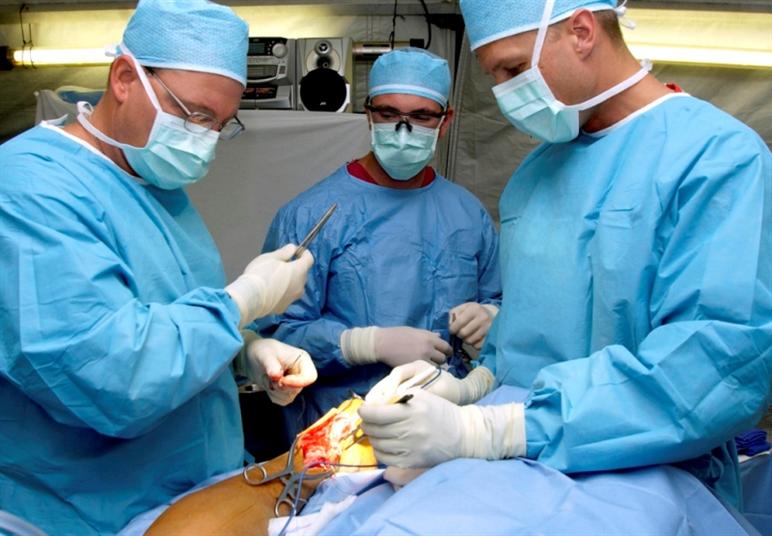
If bones are damaged, large fragments are repositioned during surgery. Small fragments of bone tissue are removed. Complex and unstable fractures require skeletal traction.
If the wound has a small diameter, it is not sutured, but simply treated with antiseptic drugs and bandaged. In case of a large defect, the edges are compared and sutured with single small sutures. Conservative treatment can be carried out only in the case of shallow tangential gunshot wounds, multiple shrapnel and superficial injuries.
After the operation, the patient is prescribed antibiotics and undergoes regular dressing changes. Sometimes after 5-6 days the patient may receive delayed primary sutures, after two weeks early secondary sutures and after three weeks late secondary sutures. The fact is that gunshot injuries rot during the healing process, and after some time they require operations: plastic surgery of the skin, tendons, restoration of nerves, etc.
Head wounds
Gunshot wounds to the head are varied. They are made from pistols, shotguns, and self-propelled guns. No less dangerous are injuries caused by objects that are not classified as firearms: spearfishing devices, crossbows or pneumatic guns.
A characteristic feature of “modern” head wounds is the “point” location of multiple wounds (no more than 2-3 mm in diameter). Most often they are obtained as a result of being hit by a shot. If a shot is fired into the head from a long distance and the bullet hits the scalp, it is difficult to determine the wound during the initial examination. When shot at point-blank range or at close range, the wounds are deep and have a large volume.
Note!
The specificity of a bullet head injury is that its magnitude does not indicate the severity of the injury. A minimal wound opening may conceal deep brain damage. Whereas a tangential wound with deep damage to the skin and soft tissues will not be so dangerous.
In the case of a head wound, the victim’s condition is assessed based on 3 factors:
- Reaction of the eyes to irritation by sound and pain;
- Verbal answers to asked questions;
- Motor ability.
Wounds to the head are often accompanied by traumatic shock. Its appearance is provoked by large external or internal blood loss. Therefore, the victim falls into an unconscious state and it is extremely difficult to bring him out of it.
Note!
If the victim has a decrease in the number of heart contractions, this indicates a developing intracranial hematoma. In this case, only emergency surgery can save a person.
In case of a gunshot wound to the head, it is important to try to bring the victim out of shock. For this purpose, analgesics that do not contain narcotic components are used. The use of non-steroidal anti-inflammatory drugs with an analgesic effect is also indicated.
Note!
Bone fragments or foreign objects that have entered the wound cannot be removed independently. This will cause profuse bleeding. Before the ambulance arrives or the victim is taken to the hospital, you can only apply a sterile bandage to the wound. For severe bleeding, use a pressure bandage.
Considering that foreign objects (bullets, shrapnel) change their location while the patient is being moved to a medical facility, transportation is carried out with extreme caution. If there is no consciousness, the patient is placed on his side. If there is vomit, blood and mucus in the oral cavity, it must be cleaned before transportation.
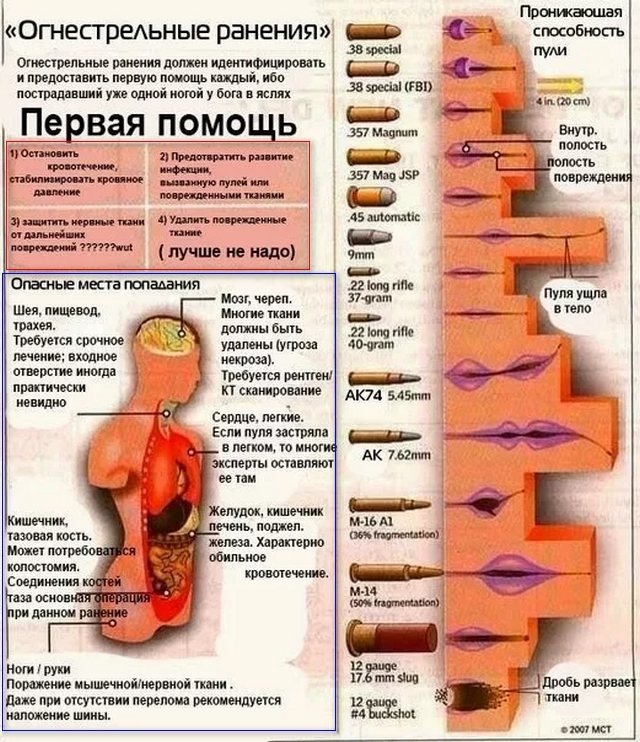
Removing the bullet
As mentioned above, gunshot wounds are very dangerous to human life (photos of the wounded are the first confirmation of this). However, in some cases, if there is absolutely no way to get qualified medical care, you can try to remove the bullet yourself. But this must be done very carefully and only if the arrival of doctors is impossible for certain reasons. Algorithm of actions:
- First, the one who will carry out all the actions prepares. Hands need to be treated with antiseptic.
- The skin around the wound is treated with an antiseptic.
- If possible, you should give pain relief to the wounded person. This could be the drug “Spazmalgon” or an ampoule of the drug “Novocain”. If this is not the case, a hard object should be given to the person’s teeth.
- Using a knife, you need to slightly increase the size of the bullet hole. Next, treat everything again with an antiseptic.
- Using treated tweezers, you need to try to get the bullet. You must try not to touch large blood arteries, as a person may die due to hemorrhagic shock, i.e. blood loss.
- After the operation, the wound must be treated again and a bandage applied.
Abdominal injuries
Open abdominal injuries:
- Non-penetrating.
- Penetrating without damaging internal organs.
- Penetrating with damage to internal organs.
In addition, abdominal injuries can be isolated (one injury), multiple (several injuries, for example, multiple wounds in the abdominal area) and combined (combined with damage to other organs and systems).
Open abdominal injuries
Open damage can be caused by a firearm, bladed weapon, or secondary projectile.
Cut wounds are inflicted with a knife. Incised wounds have the shape of a line and are quite long in length. The edges are smooth. Often such abdominal injuries are accompanied by significant external bleeding due to the intersection of a large number of vessels. With extensive damage, eventration is possible - a condition in which an abdominal organ falls into the wound.
Puncture wounds can be inflicted with a thin knife, bayonet, narrow stiletto, scissors, awl or table fork. Puncture wounds have a thin wound channel and usually bleed slightly.
In this case, a greater depth of the wound channel and serious damage to internal organs is possible.
They pose a serious threat because the patient, seeing a small wound, may underestimate the danger and seek help too late.
Chopped wounds occur when struck with an axe. They are large with fairly jagged edges, with profuse bleeding and extensive soft tissue damage.
Lacerations are caused by animal attacks or mechanical damage due to work-related injury (for example, contact with a fan blade).
These are the most severe, extensive and traumatic wounds. In such cases, tissues and organs have multiple injuries with crushing and ruptures.
In addition, as a rule, lacerations are accompanied by severe tissue contamination.
Gunshot wounds also belong to the group of particularly severe injuries, since they are accompanied not only by the formation of a wound channel, but also by tissue contusion at a distance of approximately 30 times the diameter of the bullet or pellet.
Due to contusion, tissues and organs are stretched, compressed, separated or torn.
In addition, abdominal trauma from a gunshot wound may not be obvious, since the entry holes in 50% of cases are not located on the anterior abdominal wall, but in other places (for example, on the side or in the lumbar region).
If damaged by a secondary projectile (metal part, glass fragment, etc.), lacerations and bruises occur. This type of abdominal injury is common in work accidents and car accidents.
Closed (blunt) abdominal injuries
A bruise of the abdominal wall is accompanied by pain and local swelling of the injury area. Hemorrhages and abrasions are possible. The pain intensifies with defecation, sneezing, coughing and changing body position.
Rupture of the muscles and fascia of the abdominal wall is manifested by the same symptoms, however, the pain in this case is more severe, so dynamic intestinal obstruction may develop due to reflex intestinal paresis. Additional examination is necessary to exclude ruptures of parenchymal and hollow organs.
Rupture of the small intestine usually occurs from a direct blow to the abdominal area. Accompanied by intensifying and spreading abdominal pain, tension in the muscles of the abdominal wall, increased heart rate and vomiting. The development of traumatic shock is possible.
Rupture of the large intestine is similar in symptoms to ruptures of the small intestine, however, tension in the abdominal wall and signs of intra-abdominal bleeding are often detected. Shock develops more often than with ruptures of the small intestine.
Liver damage occurs quite often with abdominal trauma. Both subcapsular cracks or ruptures and complete separation of individual parts of the liver are possible. In the vast majority of cases, such liver injury is accompanied by heavy internal bleeding.
The patient's condition is serious, loss of consciousness is possible. With preserved consciousness, the patient complains of pain in the right hypochondrium, which can radiate to the right supraclavicular region. The skin is pale, pulse and breathing are rapid, blood pressure is reduced.
Signs of traumatic shock.
Damage to the spleen is the most common injury in blunt abdominal trauma, accounting for 30% of the total number of injuries involving violation of the integrity of the abdominal organs. It can be primary (symptoms appear immediately after the injury) or secondary (symptoms appear days or even weeks later). Secondary splenic ruptures are usually observed in children.
With small ruptures, bleeding stops due to the formation of a blood clot. With major injuries, profuse internal bleeding occurs with accumulation of blood in the abdominal cavity (hemoperitoneum).
The condition is serious, shock, drop in pressure, increased heart rate and breathing. The patient experiences pain in the left hypochondrium, possibly radiating to the left shoulder.
The pain is relieved by lying on the left side with the legs bent and pulled towards the stomach.
Damage to the pancreas . They usually occur with severe abdominal injuries and are often combined with damage to other organs (intestines, liver, kidneys and spleen).
Possible concussion of the pancreas, its bruise or rupture. The patient complains of sharp pain in the epigastric region.
The condition is serious, the stomach is swollen, the muscles of the anterior abdominal wall are tense, the pulse is increased, blood pressure is reduced.
Kidney damage due to blunt abdominal trauma is quite rare. This is due to the location of the organ, which lies in the retroperitoneal space and is surrounded on all sides by other organs and tissues.
When a bruise or concussion occurs, pain in the lumbar region, gross hematuria (excretion of bloody urine) and fever appear. More severe kidney injuries (crushed or ruptured) usually occur with severe abdominal trauma and are combined with damage to other organs.
Characterized by a state of shock, pain, muscle tension in the lumbar region and hypochondrium on the side of the damaged kidney, a drop in blood pressure, and tachycardia.
Bladder rupture can be extraperitoneal or intraperitoneal. The cause is blunt trauma to the abdomen with a full bladder. An extraperitoneal rupture is characterized by a false urge to urinate, pain and swelling of the perineum. It is possible to pass a small amount of bloody urine.
Intraperitoneal rupture of the bladder is accompanied by pain in the lower abdomen and frequent false urge to urinate. Due to urine spilled into the abdominal cavity, peritonitis develops. The abdomen is soft, moderately painful on palpation, bloating and weakening of intestinal peristalsis are noted.
Diagnosis of abdominal trauma
Suspicion of abdominal injury is an indication for immediate delivery of the patient to the hospital for diagnosis and further treatment. In such a situation, it is extremely important to assess the nature of the damage as quickly as possible and, first of all, to identify bleeding, which may threaten the patient’s life.
Upon admission, in all cases, blood and urine tests are required, and the blood type and Rh factor are determined. Other research methods are selected individually, taking into account the clinical manifestations and severity of the patient’s condition.
With the advent of modern, more accurate research methods, radiography of the abdominal cavity in abdominal trauma has partially lost its diagnostic value. However, it can be used to detect ruptures of hollow organs.
X-ray examination is also indicated for gunshot wounds (to determine the location of foreign bodies - bullets or shot) and if there is a suspicion of concomitant pelvic fracture or chest injury.
An accessible and informative research method is ultrasound, which allows you to diagnose intra-abdominal bleeding and detect subcapsular damage to organs that may become a source of bleeding in the future.
If appropriate equipment is available, computed tomography is used to examine a patient with abdominal trauma, which allows a detailed study of the structure and condition of the internal organs, revealing even minor injuries and minor bleeding.
If a bladder rupture is suspected, catheterization is indicated - the diagnosis is confirmed by a small amount of bloody urine released through the catheter. In doubtful cases, it is necessary to perform ascending cystography, which reveals the presence of a radiopaque solution in the peri-vesical tissue.
One of the most effective diagnostic methods for abdominal trauma is laparoscopy.
An endoscope is inserted into the abdominal cavity through a small incision, through which you can directly see the internal organs, assess the degree of their confirmation and clearly determine the indications for surgery.
In some cases, laparoscopy is not only a diagnostic, but also a therapeutic technique, with which you can stop bleeding and remove blood from the abdominal cavity.
Treatment of abdominal injuries
Open wounds are an indication for emergency surgery. For superficial wounds that do not penetrate the abdominal cavity, the usual primary surgical treatment is performed with washing the wound cavity, excision of non-viable and heavily contaminated tissue and suturing. For penetrating wounds, the nature of the surgical intervention depends on the presence of damage to any organs.
Bruises of the abdominal wall, as well as ruptures of muscles and fascia are treated conservatively. Bed rest, cold and physiotherapy are prescribed. For large hematomas, puncture or opening and drainage of the hematoma may be necessary.
Ruptures of parenchymal and hollow organs, as well as intra-abdominal bleeding are indications for emergency surgery. A midline laparotomy is performed under general anesthesia.
Through a wide incision, the surgeon carefully examines the abdominal organs, identifies and repairs damage. In the postoperative period, in case of abdominal trauma, analgesics are prescribed and antibiotic therapy is carried out.
If necessary, blood and blood substitutes are transfused during the operation and in the postoperative period.
Source: https://www.krasotaimedicina.ru/diseases/traumatology/abdominal-trauma
What are the types of surgeries for abdominal trauma and wounds?
After collecting anamnesis, a decision on treatment is made. For blunt injuries and minor bruises without the formation of extensive hematomas, a conservative method is possible. In case of penetrating abdominal wounds, internal bleeding, organ damage and eventration into the cavity, the victims are advised to undergo surgical intervention by laparotomy.
After initial surface treatment, access to damaged tissues and organs is achieved by increasing the incision.
Internal bleeding and blood clots are removed with an electric suction. At the same time, an audit of the integrity of the organs and vessels of the abdomen and anti-shock drug therapy are carried out. The patient is under anesthesia at this time.
The viability of damaged tissues is determined by excision of necrotic areas and suturing. After restoring the integrity of the organs, the peritoneum is washed with aseptic solutions. The wound is sutured and drainage is installed.
At the end of the operation, the patient undergoes a course of inpatient treatment, where the operating surgeon observes how the wound will heal.
Gunshot wounds to the chest
A gunshot to the chest refers to difficult circumstances and is accompanied by shock and complications. Fragments and ricochet bullets cause destruction of the ribs, sternum, shoulder blades, and damage the lungs and pleura.
Bone fragments penetrate deeply into the lung tissue, and pneumo- and/or hemothorax is possible.
When organs inside the chest are damaged, blood fluid does not always flow out; sometimes it accumulates there, so it is difficult to judge damage to blood vessels from gunshot wounds.
Hemothorax
When blood enters the chest cavity, hemothorax occurs, the blood interferes with breathing, disrupts the functions of the heart, since the volume of the chest has a limit, and blood occupies the entire volume.
Pneumothorax
Air leaks into the pleura through the wound, and the presence of constant communication with the atmosphere causes open pneumothorax. Sometimes the entrance hole of the wound is clamped, then the open pneumothorax turns into a closed one.
Pneumothorax with a valve also occurs, when air freely enters the chest cavity, but the valve, which was formed as a result of a gunshot wound, prevents its return from exiting.
When providing first aid for a gunshot wound to the chest, you need to take into account the person’s condition and the nature of the wound:
- Penetrating wounds with small entry and exit wounds and blind wounds should not be touched unless there is bleeding or pneumothorax. Such wounds should be treated with any antiseptic, then a bandage should be applied;
- In the presence of pneumothorax, the entrance and exit openings of the wound are closed with a sealed, waterproof material. A piece of oilcloth or polyethylene through a napkin should be applied to the wound, then secure it with a gauze bandage.
If the bullet hit the heart, we can assume the worst case scenario . Based on the external signs of the victim - the person quickly loses consciousness, the face takes on an earthy hue - it immediately becomes clear what happened, but death does not always occur.
Quick delivery of the victim to doctors, where he will undergo drainage and suturing of the heart wound, can save a life.
First aid
Correctly provided first aid for a gunshot wound is very important. After all, sometimes it happens that before the ambulance arrives, a person can die, simply without waiting for the simplest actions from strangers. And everything happens because people most often simply do not know what is the right thing to do and what needs to be done to protect a person from death. How can you help a victim if he has a gunshot wound?
- At the very beginning, the wound must be freed from clothing. This is necessary in order to evaluate it and understand how serious the bleeding is.
- Next, it is imperative to stop the bleeding, even if it is insignificant at first glance. If there is not much blood coming out, you can simply raise the wound site so that it cannot leak out (if the limbs are injured). Otherwise, the bleeding site must be pinched with a finger (by squeezing the blood artery). Next, you need to try to apply a tourniquet slightly above the wound itself. If there is nothing suitable at hand, you need to tear off a strip of fabric from your clothing and firmly press the area above the wound.
- Treatment of the wound. Only if the bleeding has stopped should you try to wash and disinfect the wound. For this, it is good to use alcohol or hydrogen peroxide. Next, the area around can be treated with iodine to avoid infection. And only after this can the wound be bandaged with a sterile bandage. All these medications should be in any car first aid kit. So if a gunshot wound occurs, you should try to stop any car and ask the driver for a first aid kit.
- If the bullet hits the bone (it is very difficult to determine this “by eye”), the site of the wound must be carefully recorded. So, you will need to apply a splint. Any available materials can be useful for this.
- It is important to remember that a person with a gunshot wound cannot always be moved or transported independently. Sometimes a bullet damages internal organs in such a way that the slightest unskilled movement can greatly harm a person. So it is best not to touch the wounded person until the ambulance arrives. The only thing is that you need to try to protect it from hypothermia, overheating or rain.
